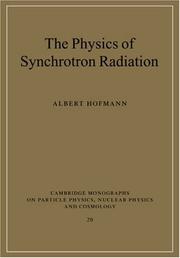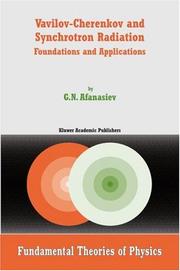| Listing 1 - 10 of 42 | << page >> |
Sort by
|
Book
Year: 1968 Publisher: Washington, D.C. : National Aeronautics and Space Administration,
Abstract | Keywords | Export | Availability | Bookmark
 Loading...
Loading...Choose an application
- Reference Manager
- EndNote
- RefWorks (Direct export to RefWorks)
Bremsstrahlung. --- Electrons --- Scattering.
Book
Year: 1988 Publisher: Gaithersburg, MD : U.S. Dept. of Commerce, National Institute of Standards and Technology,
Abstract | Keywords | Export | Availability | Bookmark
 Loading...
Loading...Choose an application
- Reference Manager
- EndNote
- RefWorks (Direct export to RefWorks)
Book
ISBN: 1316995747 1108100430 1108103235 Year: 2021 Publisher: Cambridge : Cambridge University Press,
Abstract | Keywords | Export | Availability | Bookmark
 Loading...
Loading...Choose an application
- Reference Manager
- EndNote
- RefWorks (Direct export to RefWorks)
Learn about the properties of synchrotron radiation and its wide range of applications in physics, materials science and chemistry with this invaluable reference. This thorough text describes the physical principles of the subject, its source and methods of delivery to the sample, as well as the different techniques that use synchrotron radiation to analyse the electronic properties and structure of crystalline and non-crystalline materials and surfaces. Explains applications to study the structure and electronic properties of materials on a microscopic, nanoscopic and atomic scale. An excellent resource for current and future users of these facilities, showing how the available techniques can complement information obtained in users' home laboratories. Perfect for graduate and senior undergraduate students taking specialist courses in synchrotron radiation, in addition to new and established researchers in the field.

ISBN: 1281935476 9786611935474 9812795006 9789812795007 9789812385789 9812385789 9812385789 Year: 2004 Publisher: River Edge, NJ World Scientific
Abstract | Keywords | Export | Availability | Bookmark
 Loading...
Loading...Choose an application
- Reference Manager
- EndNote
- RefWorks (Direct export to RefWorks)
This book deals with the theory and experiment of the elementary process of bremsstrahlung, where photons are detected in coincidence with decelerated outgoing electrons. Such experiments allow for a more stringent check of the theoretical work. The main emphasis is laid on electron-atom bremsstrahlung and electron-electron bremsstrahlung, but further bremsstrahlung processes are also dealt with. In the theoretical parts, triply differential cross sections are derived in various approximations, including electron spin and photon-polarization. In the experimental sections, electron-photon coin
Bremsstrahlung. --- Braking radiation --- Nuclear reactions --- Plasma radiation --- Radiation
Book
ISBN: 1838804420 1838806466 1838804412 Year: 2019 Publisher: IntechOpen
Abstract | Keywords | Export | Availability | Bookmark
 Loading...
Loading...Choose an application
- Reference Manager
- EndNote
- RefWorks (Direct export to RefWorks)
In this book, the readers will find chapters exposing them to different, useful applications of synchrotron radiation in various fields of physics, archeology, and biosciences. Different research has been carried out in this field and has conveyed a novel approach to the applications of synchrotron radiation.The chapters are crisp and precise and will motivate students, young researchers, and professionals to carry out research with novel ideas. The authors have successfully tried to convey their ideas in a very simple text. It will be useful for both the novice and those who are currently doing research in this field. I hope it will complete my task of enriching researcher into synchrotron radiation with better applications and also giving students a better platform for understanding the subject.

ISBN: 9780521037532 9780521308267 0521037530 0521308267 9780511534973 0511196180 9780511196188 0511195524 9780511195525 0511534973 9780511192005 0511192002 9780511194146 0511194145 9786610477463 6610477469 0511194161 9780511194160 1107141419 1280477466 0511313977 Year: 2004 Volume: 20 Publisher: Cambridge, U.K. New York Cambridge University Press
Abstract | Keywords | Export | Availability | Bookmark
 Loading...
Loading...Choose an application
- Reference Manager
- EndNote
- RefWorks (Direct export to RefWorks)
This book explains the underlying physics of synchrotron radiation and derives its main properties. It is divided into four parts. The first covers the general case of the electromagnetic fields created by an accelerated relativistic charge. The second part concentrates on the radiation emitted by a charge moving on a circular trajectory. The third looks at undulator radiation, covering plane weak undulators, strong undulators and other more general undulators. The final part deals with applications and investigates the optics of synchrotron radiation dominated by diffraction due to the small opening angle. It also includes a description of electron storage rings as radiation sources and the effect of the emitted radiation on the electron beam. This book provides a valuable reference for scientists and engineers in the field of accelerators, and all users of synchrotron radiation.
Book
ISBN: 0195045246 9780195045246 Year: 1988 Publisher: New York (N.Y.): Oxford university press
Abstract | Keywords | Export | Availability | Bookmark
 Loading...
Loading...Choose an application
- Reference Manager
- EndNote
- RefWorks (Direct export to RefWorks)
Theoretical spectroscopy. Spectroscopic techniques --- fysicochemie --- Experimental nuclear and elementary particle physics --- Synchrotron radiation --- Bremsstrahlung, Magnetic --- Emission, Synchrotron --- Magnetic bremsstrahlung --- Synchrotron emission --- Electromagnetic waves --- Particles (Nuclear physics) --- Synchrotron radiation.

ISBN: 1280190078 9786610190072 1402024118 140202410X Year: 2004 Volume: 142 Publisher: Dordrecht ; Boston : Kluwer Academic Publishers,
Abstract | Keywords | Export | Availability | Bookmark
 Loading...
Loading...Choose an application
- Reference Manager
- EndNote
- RefWorks (Direct export to RefWorks)
The theory of the Vavilov-Cherenkov radiation observed by Cherenkov in 1934 was created by Tamm, Frank and Ginsburg who associated the observed blue light with the uniform charge motion of a charge at the velocity greater than the velocity of light velocity in the medium. On the other hand, Vavilov, Cherenkov's teacher, attributed the observed blue light with the deceleration of electrons. This has given rise to the appearance of papers in which the radiation of a charge uniformly moving in a finite space interval was related to the bremsstrahlung arising at the end points of the motion interv
Cherenkov radiation. --- Synchrotron radiation --- Scientific applications. --- Bremsstrahlung, Magnetic --- Emission, Synchrotron --- Magnetic bremsstrahlung --- Synchrotron emission --- Cerenkov radiation --- Cherenkov light --- Vavilov-Cherenkov radiation --- Electromagnetic waves --- Particles (Nuclear physics) --- Optics --- Radiation
Periodical
Abstract | Keywords | Export | Availability | Bookmark
 Loading...
Loading...Choose an application
- Reference Manager
- EndNote
- RefWorks (Direct export to RefWorks)
Synchrotron radiation --- Synchrotron radiation sources --- Synchrotron radiation. --- Synchrotron radiation sources. --- Radiation sources, Synchrotron --- Bremsstrahlung, Magnetic --- Emission, Synchrotron --- Magnetic bremsstrahlung --- Synchrotron emission --- Radiation sources --- Electromagnetic waves --- Particles (Nuclear physics)
Periodical
ISSN: 16005775 09090495 Year: 1994 Publisher: Copenhagen, Denmark : Published for the International Union of Crystallography by Munksgaard,
Abstract | Keywords | Export | Availability | Bookmark
 Loading...
Loading...Choose an application
- Reference Manager
- EndNote
- RefWorks (Direct export to RefWorks)
Synchrotron radiation --- Synchrotrons --- Radiation --- Industrial applications --- Radiation. --- Synchrotrons. --- Synchrotron --- Radiations --- Bremsstrahlung, Magnetic --- Emission, Synchrotron --- Magnetic bremsstrahlung --- Synchrotron emission --- Dose Hypofractionation --- Electromagnetic waves --- Particles (Nuclear physics) --- Radiation Dose Hypofractionation
| Listing 1 - 10 of 42 | << page >> |
Sort by
|

 Search
Search Feedback
Feedback About UniCat
About UniCat  Help
Help News
News